Royals motor through Detroit
Today, a closer look at the role the rotation has played in this stretch, the success of the bottom third of the lineup and lefty Jake Brentz.
The Royals cruised into Motown and thus far have tamed the Tigers. Three games, three wins. Another series victory for those of you keeping track. And with the win in the series finale against the Tampa Bay Rays prior to heading on the road, it’s now four wins in a row. It’s officially a streak.
They’re doing it in myriad ways. Home runs from Andrew Benintendi and Ryan O’Hearn (did you really think you would be reading that phrase a week ago?) propelled them to victory on Friday. Stellar starts from the young gun Brady Singer and the wily veteran Danny Duffy led to wins over the weekend. All the while the bullpen has destroyed the will of opposing batters to live.
Salvador Perez has cooled off since his torrid homestand—you seriously can’t expect him to do it single-handedly every game—but others have picked up the slack. On Sunday the sixth through nine spots in the order combined to go 6-14 with three runs scored, effectively setting the table for the top of the order to bring them home.
Let’s go.
The heavy lifting of the rotation
It feels premature to anoint the Royals’ starting rotation as a strength…but let’s just say they’ve been pulling their weight during this 12 game stretch where they’ve won nine. Duffy has been the anchor man, making the first start in this timeline (April 13 against the Angels in the second game of that 10-game homestand) and now two more, including Sunday’s matinee victory.
The starting pitching in the Detroit series in particular has been…chef’s kiss. Granted, this is the Tiger lineup. It’s not great. Still, the work turned in by Mike Minor on Friday, Brady Singer on Saturday and Duffy on Sunday has been exceptional. The trio has combined for 17.2 innings of work with 11 hits, 2 walks (both belonging to Minor) and 25 strikeouts. They’ve allowed just three runs…all coming on a pair of home runs—a two-run shot against Minor on Friday and a solo homer off Singer on Saturday.
Singer’s performance deserves a bit of a deeper dive. The dude flat attacked. He worked with tempo and purpose. Tiger batters put 16 balls in play, but only six were hard-hit and the 16 carried an average exit velocity of—get this—81.8 mph. That’s absurd.
The home run pitch to Willi Castro wasn’t in a poor location at all. Castro is a switch hitter and was hitting from the left side against the righty Singer. The pitch down and in is usually in the left-handed batter’s hot zone, but Castro has more swing and miss there. He will miss on that pitch in that location around 45 percent of the time. He had never hit a pitch located in that area out of the yard before Saturday. Furthermore, f the 140 or so pitches Castro had seen in that location as a left-handed batter, he had hit just four of them with an exit velocity over 95 mph. It really wasn’t a bad pitch.
In Saturday’s game, Singer worked exclusively sinker/slider. He had a 34 percent CSW% (called strikes plus whiffs), which is a very strong rate.
Singer caught probably a bit more of the zone in the lower half than you would like with the sinker, but with the way he was tunneling his pitches, the batters were probably reading that as a slider, expecting it to move to the left side of the plate. As you can see from the results on the right, no damage was done against those sinkers.
The ones elevated were the neighborhood where the swing and miss resided. Along with the sliders off the plate. Also, you can see where the home run pitch was located. Again…not a bad spot. Maybe it could’ve been a little more down, or a little more in. But that’s just nitpicking at this point.
Duffy was similarly dominant in his start on Sunday. His CSW% was 35 percent, on par with Singer’s from the previous afternoon. But Duffy generated a lot more miss on his swings…41 percent to be exact. I mean, his numbers were just impressive.
But Duffy did have one inning of extended trouble—the fourth—where Detroit batters fought him through 28 pitches good for three singles. That frame ultimately denied him from being able to complete six innings for the fourth consecutive start. But you have to give Duffy credit for battling through and coming out on top. Honestly, I’m not sure the Duffy we saw in 2020 or really any of the previous three seasons would’ve been able to get through that without allowing at least one run in a tight game. This is Duffy in pure attack mode. Like Singer, he’s pitching with purpose.
Seriously. A 50 percent whiff rate and one ball in play on his four-seamer…That’s just ridiculous.
Speaking of the ridiculous…In the postgame notes, the Royals PR department noted that Duffy’s ERA of 0.39 through his first four starts of the season is the second-best opening of a year since Zack Greinke twirled a 0.00 ERA in his first four starts in 2009. Any time a pitcher does something to garner a comp to 2009 Greinke, you’re going to get my attention. This is a stretch that I didn’t know Duffy had in him at this point in his career. We’ve seen several incarnations of the lefty in his 10 years in a Royals uniform. This may be the best one yet.
Length in the lineup
This winter, when the Royals talked about wanting to lengthen their lineup, it was about building a batting order that could actually produce beyond the top half. A bat like Carlos Santana was always going to slot into the top part of the order, but it would allow for the Royals to drop some better hitters still in the fold (Hunter Dozier for example) a little lower. Acquiring a guy like Micheal A. Taylor meant that they could also add some quality in the bottom part of the lineup as well.
Through the first 20 games of 2021, the idea of lengthening the lineup is working.
Again, the key column to look at here is the last one—sOPS+. That’s the OPS+ (anything greater than 100 is better than league average) for the split. So the Royals, with a 125 sOPS+ are 25 percent better than the average AL team when it comes to OPS+, ranking third in the league. Last year, the Royals’ seven through nine were 12th out of 15 teams with an sOPS+ of 87.
With offense down across baseball in the first few weeks of the season, the numbers certainly aren’t gaudy. Nor is there anything in particular that would make you sit up and take notice. But the Royals are simply one of the teams in the league getting more production from hitters seven, eight and nine.
As previously mentioned, on Friday it was the lower third who set the wheels in motion for a crooked number in the fifth inning to break the game open. On Saturday they put the ball in play to bring home both the team’s runs in the fifth. And on Sunday the seven through nine hitters went 5-10 with two runs scored. In the fifth the run came on a Taylor single, a Lopez sacrifice, a Taylor steal and a Whit Merrifield single. Lopez opened the ninth with a single, advanced to second on a wild pitch and came across as an insurance run on a Carlos Santana single.
There’s not a lot of flash in that part of the lineup, but it doesn’t matter. It’s much improved from 2020 and a huge part of why the Royals are winning games in 2021.
Locking down the Ws
I’ve written plenty in this space about Mike Matheny’s bullpen management and how well it’s been working for the Royals. I’ve written less about that specific success. Time to change that.
With all three games in Detroit relatively close, the bullpen regularly pitched in what could be considered high-leverage situations. (Less so on Friday but definitely on Saturday and for most of Sunday until the Royals added a couple of runs in the ninth.) For the series thus far, the relief corp has stymied Detroit: 9.1 IP, 2 H, 2 BB, 13 SO. Yeah, they haven’t allowed a run.
On Friday it was Tyler Zuber as the fireman to escape the fifth, followed by Jake Brentz, Kyle Zimmer and Josh Staumont to get the win. Saturday, Staumont again pitched the ninth and earned the first save of his career. He’s the sixth Royals reliever to save a victory this year. (Not great for your fantasy team, but it works for the Royals.) He was set up by Scott Barlow who pitched a clean eighth.
And on Sunday, the order was flip-flopped from Friday with Zimmer and Brentz. Wade Davis finished off the Tigers in the ninth. The Brentz outing was notable because he went two innings—the seventh and eighth—after Zimmer had the sixth.
There are plenty of weapons in the Royals’ bullpen, but the rapid emergence of Brentz has been quite enjoyable. The lefty is popping the heater at 96 mph and pairs it with a slider and occasional change. The results have been a delightful absence of hard contact and grounders (a 46 percent ground ball rate) and a 27 percent strikeout rate.
Poor JaCoby Jones didn’t stand a chance on Sunday, despite having the platoon advantage. Brentz started him off with a nasty slider that starts over the plate and cuts down and in to a right-handed batter:
The result is what the Pitching Ninja lovingly refers to as a “sword.”
With the count 0-2 courtesy of his off speed pitches, Brentz went up and away with the heat. Jones laid off so Brentz came back with the fastball, but in on the hands:
That couldn’t have felt so hot.
So at this point, Brentz is ahead in the count and has shown his complete repertoire. Where does he go to finish off Jones?
How about a change on the outer half? Yes.
Just absolute filth. Here’s a visual on how Brentz attacked that at bat from Jones.
He opened with sliders down and in before going to change-ups away and a couple of challenge fastballs. It was a masterclass of pitch variety and, more importantly, location. It was location (and command) that was the concern with Brentz coming into the year. He’s a guy who has walked a ton of hitters in his minor league journey, averaging around 6.5 BB/9 from High-A to Triple-A. This year, he’s walked just three batters while striking out 10 in nine innings of work.
Let’s expand on the quality of contact a bit. According to Baseball Savant, Brentz has allowed a hard-hit ball (exit velocity of 95 mph or greater) in 25 percent of all balls put in play. However, he has yet to be barreled and hasn’t even had what Savant characterizes as “solid” contact.
It’s for good reason Brentz has entered Matheny’s Bullpen Circle of Trust.
Hot start
We seem to say this every damn year: In order for the Royals to make any kind of noise, they need to get off to a good start. Really, it seems to me like it’s less about having a good start than avoiding the absolute April disasters we’ve seen from this franchise. So far, so good.
Twenty games into the season and, according to the Royals’ PR department, at 13-7, they are off to their fourth-best start in franchise history.
2003 — 16-4
1978 — 14-6
2015 — 14-6
2021 — 13-7
There are still 142 games to be played, so let’s not get ahead of ourselves. But it feels incumbent to note that the 1978 and 2015 teams both won over 90 games and played in the postseason. The 2003 team was way over its skis but still found a way to win 83, becoming the only Royals team in a 19-year stretch that finished above .500.
There’s no guarantee on how the 2021 Royals will finish the season, but the strong April certainly helps if they’re planning on making some noise in the Central.
Speaking of which…
Central issues
New York Yankees 3, Cleveland 7
Cleveland salvages one win in their four-game set against the Yankees. Franmail Reyes hit a go-ahead three-run homer in the fourth and added a leadoff triple in the sixth. It was their first win in a week.
Pittsburgh 6, Minnesota 2
After getting swept out of Oakland, the Twins return home and promptly drop two of three to the Pirates.
Texas 4, Chicago 8
Jose Abreu clubbed his fifth homer of the year and drove in three. Nick Madrigal tripled, singled, scored twice and drove in two. And Michael Kopech shoved for five innings, striking out 10 as the Sox swept the Rangers in three on the South Side.
The standings currently look like this:
Up next
The Royals have a Monday matinee as they close their four-game series against the Tigers. The Royals have never swept a four-game series in Detroit. For the last four-game road sweep against any opponent you have to go back to the last century: The Royals swept the Twins in four games in Minnesota in May, 1999.
All eyes will be on Brad Keller as he tries to match his rotation-mates with a good outing to close out the series. Spencer Turnbull goes for the Tigers. First pitch is 12:10.






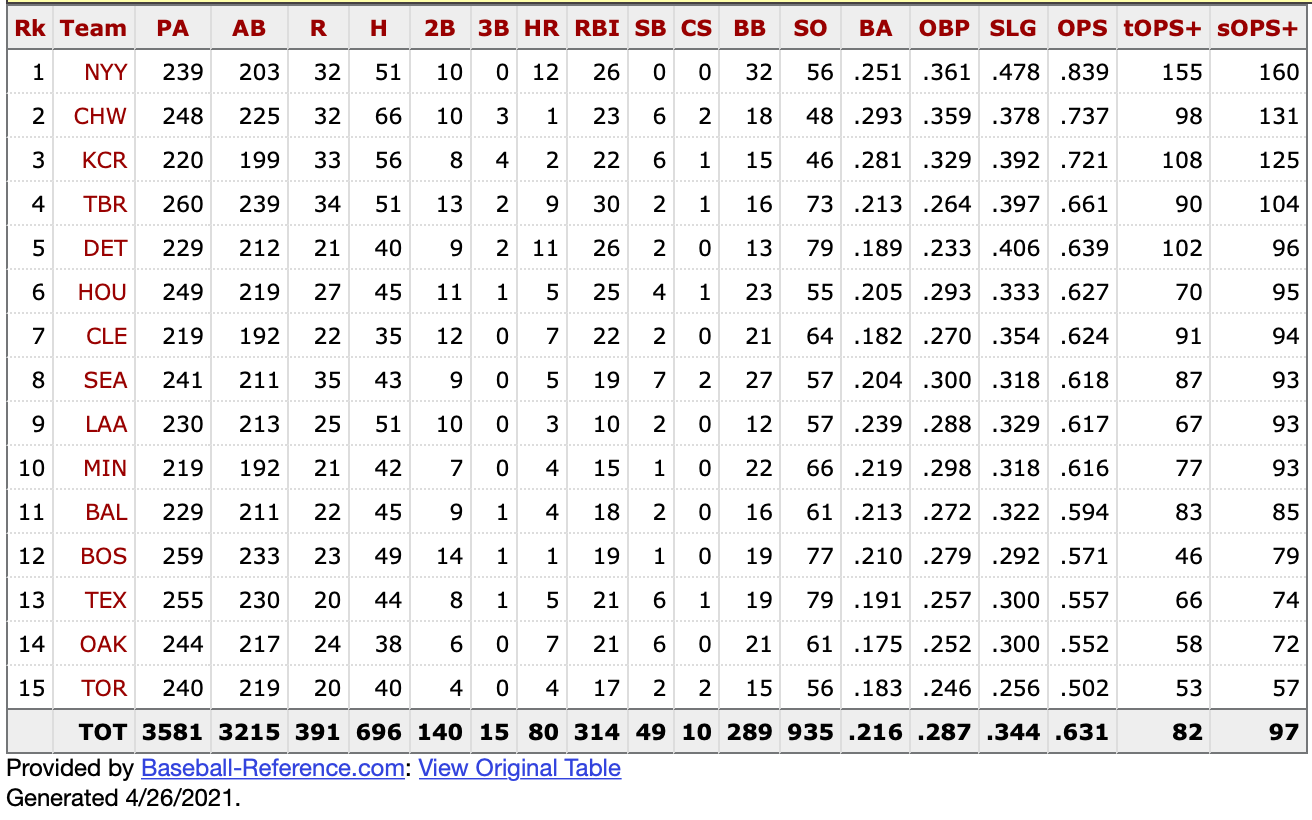
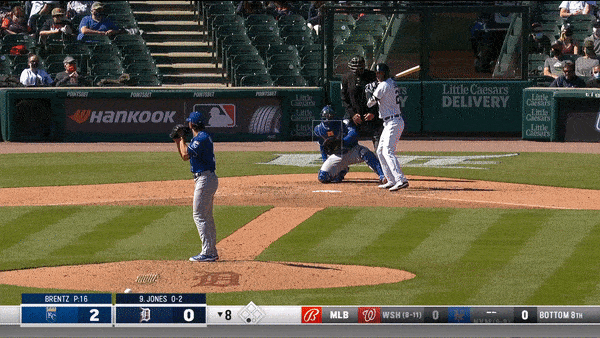
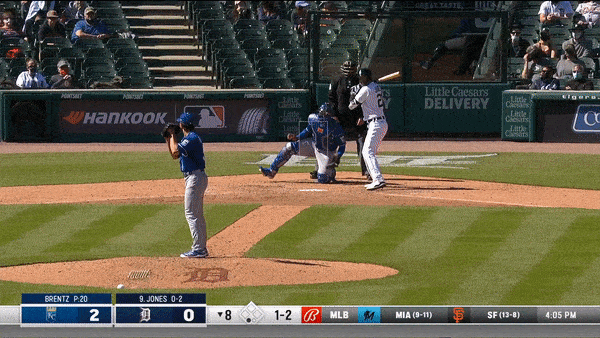
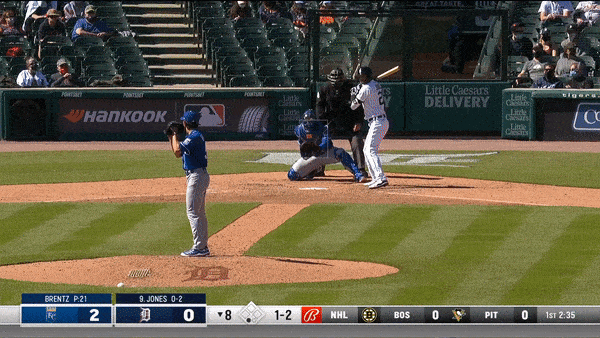
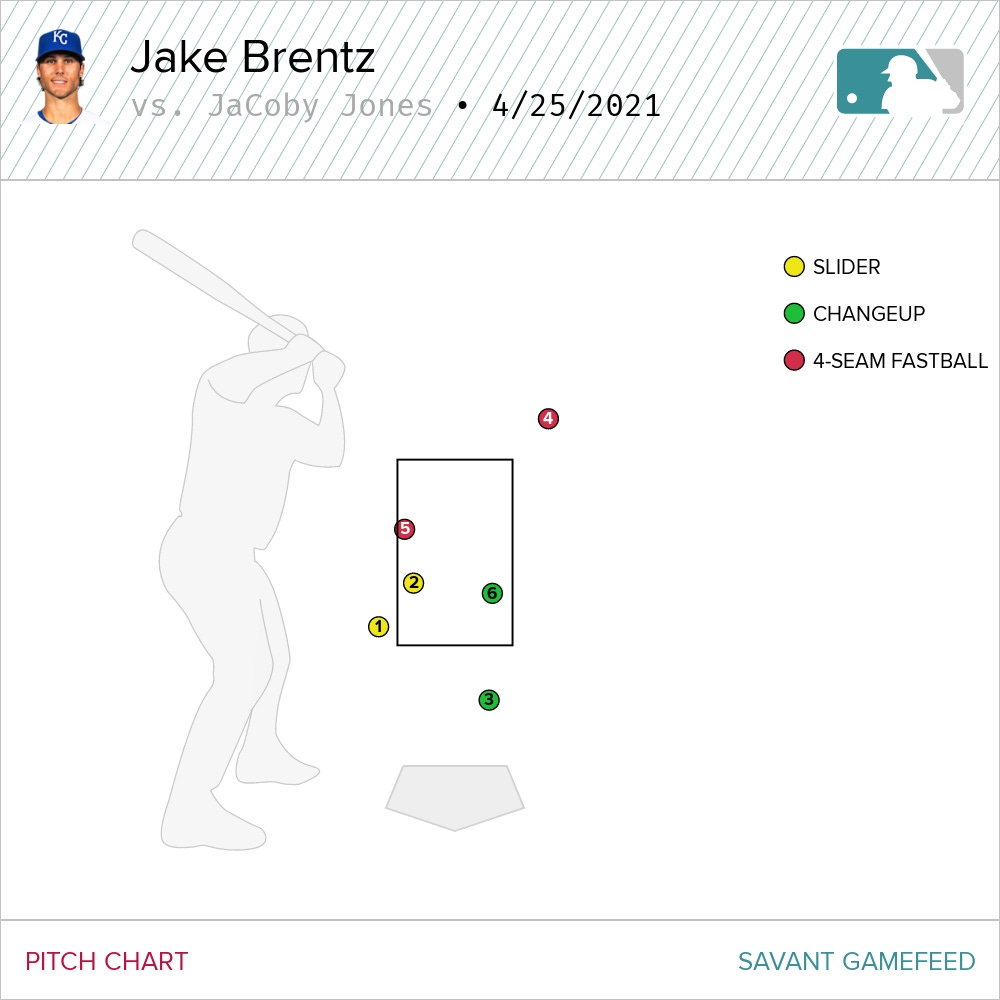
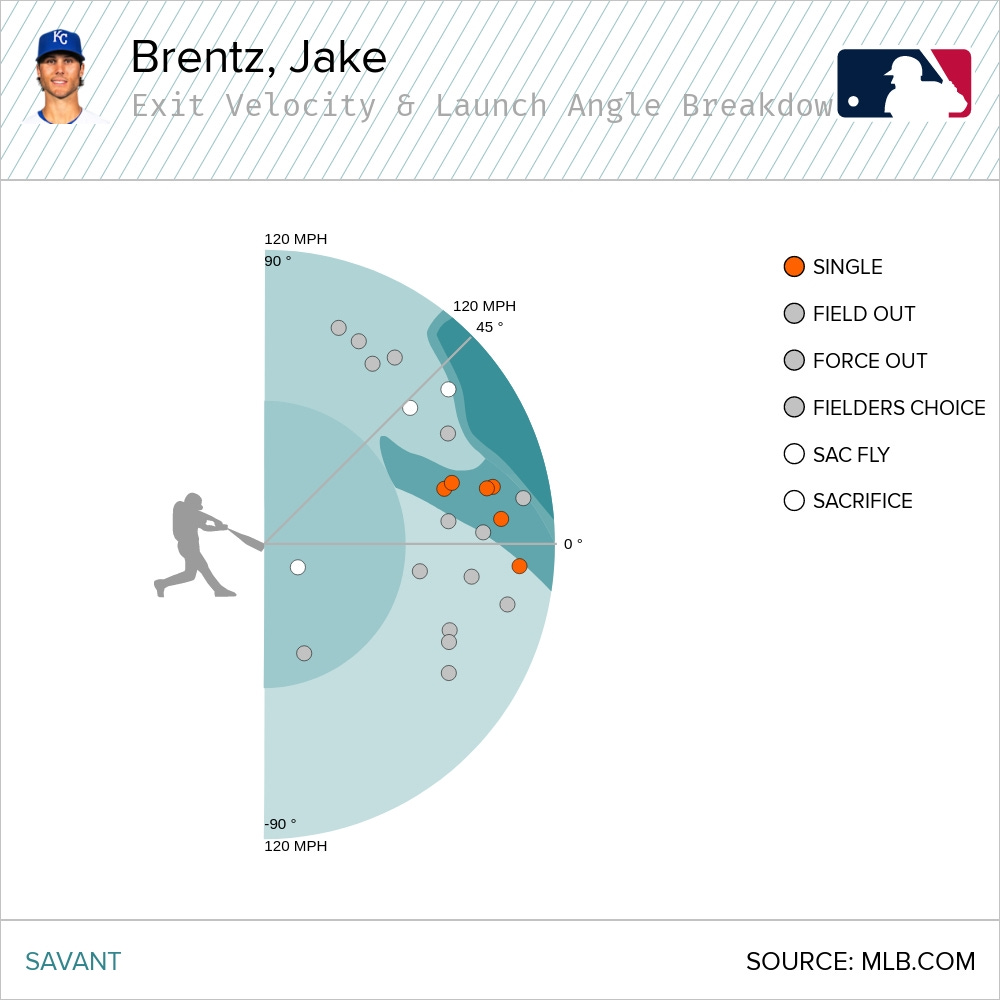
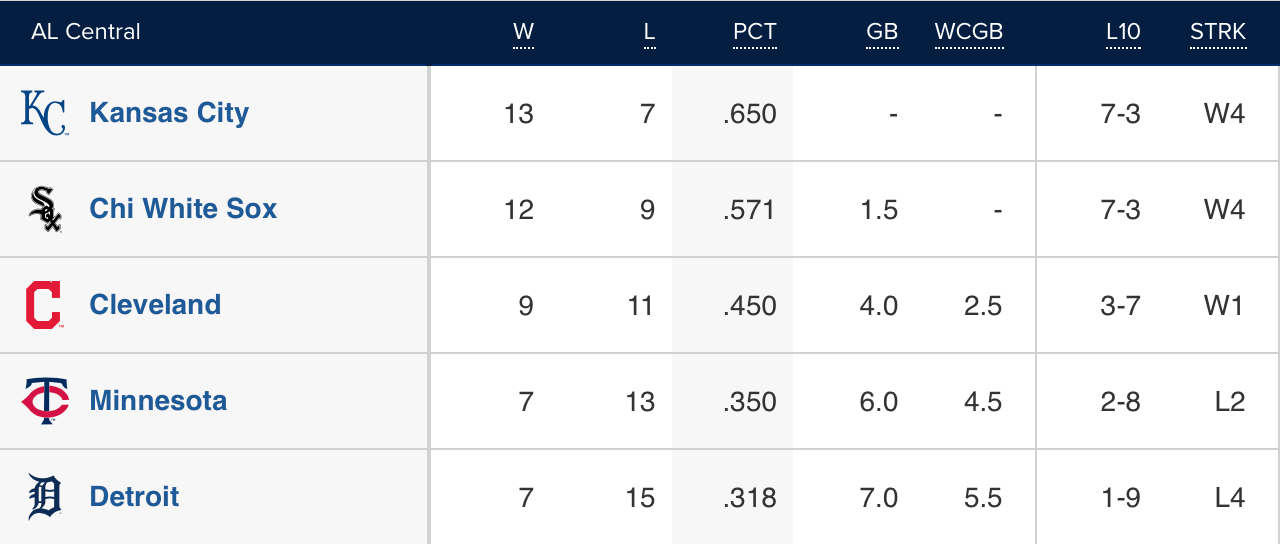
Almost the end of April and the Royals in first place? Life is good!
The pitching for the most part has been nails, starters and bp alike. Great to see Keller somehow get hammered and only give up 2 and get a win - it felt like he was about to get yanked about three times but he was crafty and got the job done.
I know that numbered rotations are so yesterday but I'm thinking Duffy, Singer (switch either of them and I'm fine), Minor, Keller, Junis.
As for the bp - great write up on Brentz - we've caught lightning in a bottle with this kid thus far! And with some surprise arms I'm wondering who is the odd man out when Mondesi is ready for recall? A pitcher or position player???
Who would you move CB?